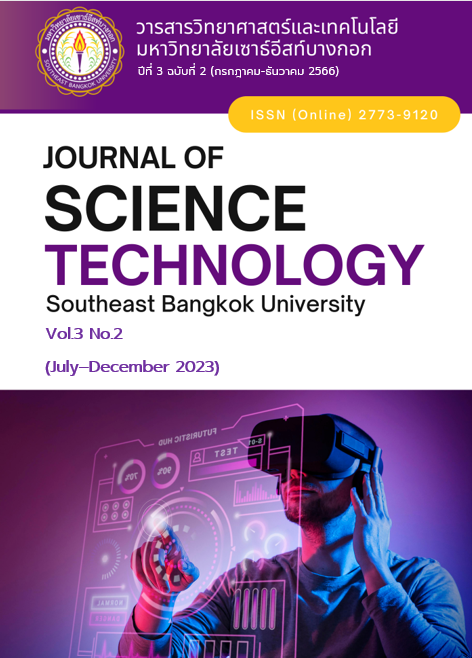THE EXPERIMENT DETERMINATION OF THE OPTIMAL MIXING RATIO OF POLYESTER FIBER SCRAP WITH 100% POLYESTER IN NONWOVEN FABRIC PRODUCTION บทความวิจัย
Main Article Content
บทคัดย่อ
The purpose of this research is to study the optimum ratio between polyester fiber scraps and virgin polyester. In the study, the production process of a nonwoven fabric manufacturer in Rayong, Thailand, it was found a problem in the production process, there is a large amount of polyester fiber scrap left from the production process. Therefore, the waste of polyester fiber from the production process was mixed with pure polyester raw material in 4 sets of ratios, namely 4:96, 6:94, 8:92, and 10:90 get to average to compare with the conditions weight values, strength, elongation, and thickness as to the testing standards by TIS no. 121 and analyzing process capability by the Actual Process Capability Index (Cpk) was used by analyzing and processing from the Minitab package to examine the variability of the production process. The results showed that the ratio was 4:96 with a mean total weight of 27.5 grams per square meter. The thickness value was 1.07 mm., the strength value was 25.85 N.m., and the elongation value was 5.05 N.M., which were in the specified criteria for all test results. The ratio was 6:94 with an average weight of 27.9 g/m. square meter The thickness value was 1.10 mm., the strength value was 24.41 N.m., and the elongation value was 4.40 N.M., were within the specified criteria for all test results and both of which had a Cpk greater than 1, indicating that the process was capable or there is a natural variance. After the improvement in the past 12 months, it was found that the amount of poly fiber scrap 58 tons of ester left over from the production process were recycled and 45 tons were recycled, representing 77.58% of the recycled polyester scrap or the efficiency of the product was 96.7
Article Details

อนุญาตภายใต้เงื่อนไข Creative Commons Attribution-NonCommercial-NoDerivatives 4.0 International License.
บทความที่ได้รับการตีพิมพ์และเป็นลิขสิทธิ์ของวารสารวิทยาศาสตร์และเทคโนโลยี มหาวิทยาลัยเซาธ์อีสท์บางกอก
เอกสารอ้างอิง
Department of Industrial Works Ministry of Industry, Industrial Data and Digital Center, “Number of workers in textile and garment factories (accumulation),” [Online]. Available: https://www.thaitextile.org/th/insign/detail.1574.1.0.html. [Accessed: June 25, 2022].
Textile Industry Development Institute, Situation of Thai Textile and Garment Industry, Industrial Data and Digital Center. “Textile Industry Development Institute: 2020,” [Online]. Available: https://www.thaitextile.org/th/insign/detail.2000.11.0.html. [Accessed: June 25, 2022].
P. Nimmanorraluk, P. Vongyuttakrai, T. Tavattana. “A Study on Waste Reduction Through Machine Adjustment and Ratio Formulation in Nonwoven Fabric Material Production,” Journal of Industrial Studies, vol.7, no.2, pp. 33-41, 2013.
S. Saikaew, S. Wiengwiset, A. Sriboonruang. “Improving the Properties of Sand Molds in the Iron Casting Industry Using Mixture Experiments,” KKU Research Journal, Vol. 16, No.2, pp. 169-78, 2011.
S. Kaewploy, K. Boonseng. “Design of Experiment for Evaluating the Optimal Condition in Drying Process of Rubberwood,” KKU Research Journal, vol.19, no.2, pp. 84-92, 2014.
S.R. Nadupuru, R.K. Jain, D.A. Joshi and R. Menon. “Experimental Analysis using Polypropylene, Polyester and Waste Denim Fiber in Road Construction,” International Conference on Recent Advances in Engineering Materials, vol.66, no.4, pp. 2363-2369, 2022.
Y. Gong, J. Song, H. Bi and Z. Tian. “Optimization Design of the Mix Ratio of a Nano-TiO2/CaCO3-Basalt Fiber Composite Modified Asphalt Mixture Based on Response Surface Methodology,” Journal: Applied Sciences, vol.10, no13, pp.1-24, July 2020.
P.P. Pichardo, G.M. Barrera, M.M. López, F.U. Núñez and J.M. Laredo. “Recovery of Cotton Fibers from Waste Blue-Jeans and its use in Polyester Concrete,” Construction and Building Materials, vol.177, pp.409-416, 20 July 2018.
B. Mirbaha, A.A. Kordani, M. Zarei and A. Zarei. “Experimental Determination of the Optimum Percentage of Asphalt Mixtures Reinforced with Nano-Carbon Black and Polyester Fiber Industries,” Engineering Solid Mechanics, vol. 5, no.4, 2017, pp. 285-292, 2017.
Thai Industrial Standards Institute. Office Industrial Product Standards, Ministry of Industry. “Standard Document Industry 121:1979,” [Online]. Available: https://www.tisi.go.th/website/standardlist/list_measures. [Accessed: June 25, 2022].
Thai Industrial Standards Institute. Office Industrial Product Standards, Ministry of Industry. “Industrial product standards Woven Fabrics-Determination of Mass per Unit Length and Mass per Unit Area TIS.121 Volume 12:2010,” [Online]. Available: http://www.fio.co.th/web/tisi_fio/fulltext/TIS121_12-2553.pdf. [Accessed: June 25, 2022].
Thai Industrial Standards Institute. Office Industrial Product Standards, Ministry of Industry. “Industrial product standards Tensile Properties of Fabrics -Determination of Maximum Force Using the Grab Method TIS.121 Volume 16:2010,” [Online]. Available: http://www.fio.co.th/web/tisi_fio/fulltext/TIS121_16-2553.pdf. [Accessed: June 25, 2022].
Thai Industrial Standards Institute. Office Industrial Product Standards, Ministry of Industry. “Industrial product standards Determination of Tear of Fabrics Using Constant Rate of Extension Testing Machine TIS.121 Volume 17:2010,” [Online]. Available: http://www.fio.co.th/web/tisi_fio/fulltext/TIS121_17-2553.pdf. [Accessed: June 25, 2022].
Thai Industrial Standards Institute. Office Industrial Product Standards, Ministry of Industry. “Industrial product standards Thickness of Fabrics TIS.121 Volume 24:2010,” [Online]. Available: http://www.fio.co.th/web/tisi_fio/fulltext/TIS121_24-2553.pdf. [Accessed: June 25, 2022].
D.C. Montgomery, Introduction to Statistical Quality Control, John Wiley & Sons Inc, New York, 2005.
B. Ramakrishnan, P.M. Sandborn Pecht, Process Capability Indices and Product Reliability, Microelectronics Reliability. 2001.
J. Sabseree, Quality Production, Technology Promotion Association (Thailand-Japan): 2007. “Process Capability Analysis,” [Online]. Available: https://www.tpa.or.th/publisher/pdfFileDownloadS/fq121_p56-59.pdf. [Accessed: Dec. 5, 2022].
R. Jaroenyot, S. Anuntaratanachai, P. Sujittamakul., Rajamangala University of Technology Suvarnabhumi: 2015. “The Study of the Qualification of Polymer Mixed Glass Fiber for the Material of the Windwheel Produced the Electric Current” [Online]. Available: https://research.rmutsb.ac.th/fullpaper/2558/2558240240238.pdf. [Accessed: Dec. 18, 2022].


